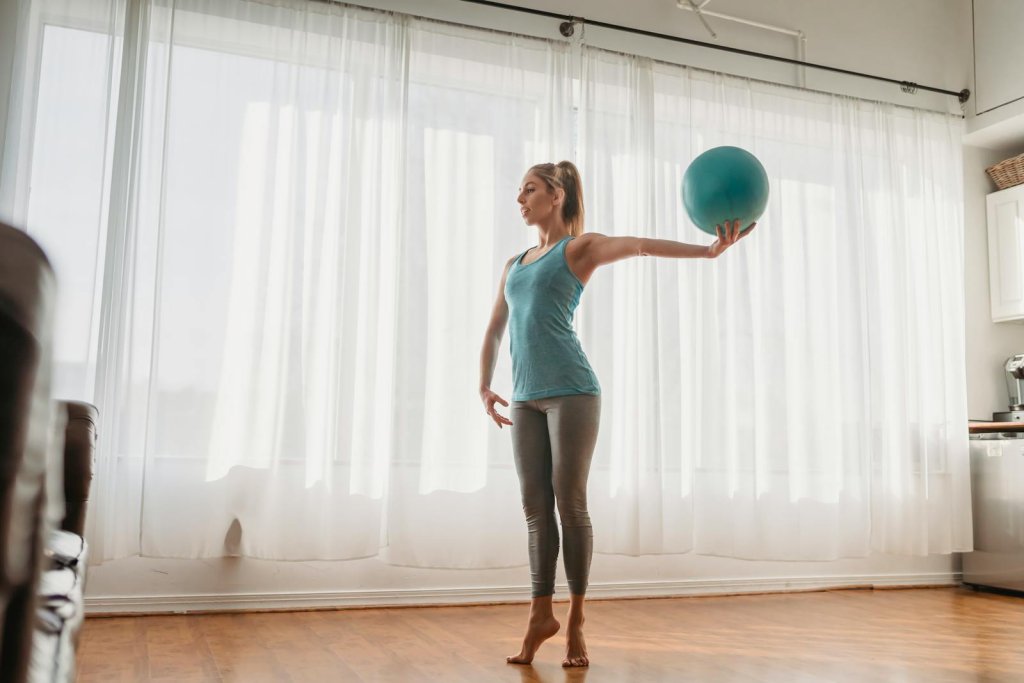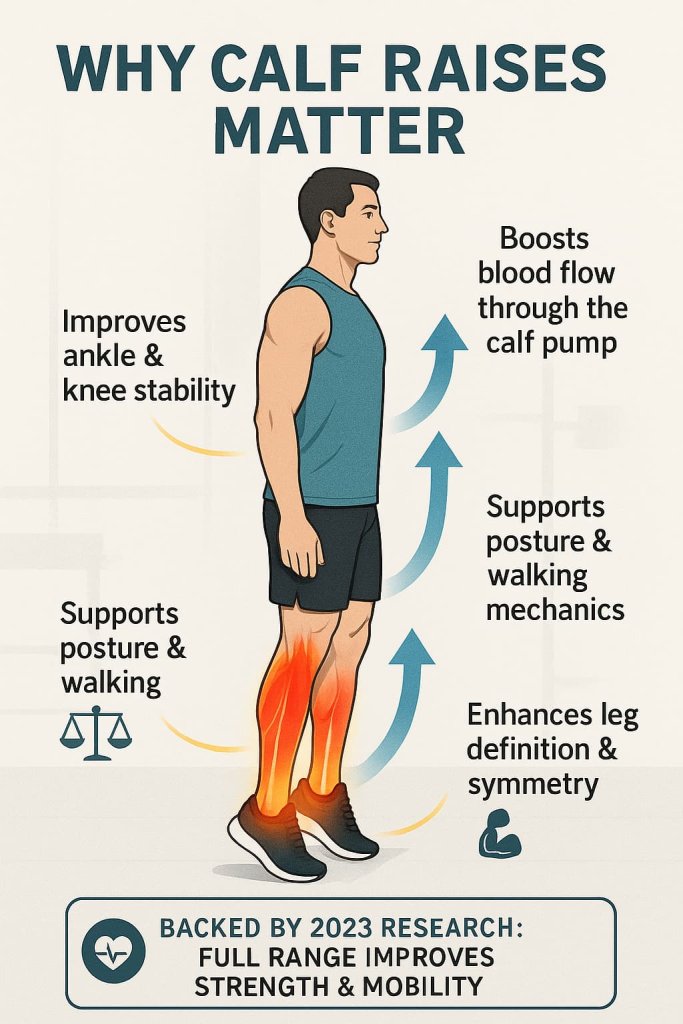Yes — calf raises are one of the most effective exercises to build strength, improve balance, and enhance definition in your lower legs.
They strengthen the gastrocnemius and soleus — the two key muscles that control your ankle movement, posture, and push-off power when you walk, run, or jump.

Understanding how to perform calf raises correctly is essential because these small muscles play a big role in balance, joint stability, and lower-body performance. In this guide, you’ll learn proper form, variations, benefits, programming tips, and research-based facts to make your calf training more effective.
Why Calf Raises Matter
Calf raises do more than shape your legs — they build a foundation for movement.
- Improve ankle and knee stability, reducing injury risk.
- Strengthen the muscles that support posture and walking mechanics.

- Boost circulation through the “calf pump,” aiding blood flow from the legs back to the heart.
- Enhance muscle definition and symmetry, balancing the look of your upper and lower body.
A 2023 Frontiers in Physiology study found that consistent calf-raise training improves muscle size and functional strength when performed through a full range of motion. Similarly, an 8-week Journal of Aging Research trial showed that home-based calf raises improved lower-leg force and mobility in older adults.
Muscles Worked in Calf Raises
Primary Muscles
- Gastrocnemius: The outer, visible part of the calf — used during standing raises and explosive movements.
- Soleus: The deeper muscle underneath — activated more during seated or bent-knee raises.

Supporting Muscles
- Tibialis posterior and peroneals (for ankle control)
- Flexor muscles of the foot (assist with stability)
Trainer Tip: Combine standing and seated calf raises to work both muscles for full development.
How to Do Calf Raises Correctly
Standing Calf Raise
- Stand tall with feet hip-width apart.
- Press through the balls of your feet to lift your heels as high as possible.
- Hold for 1–2 seconds at the top.
- Lower your heels slowly until you feel a stretch.
- Repeat 12–15 times for 3 sets.
Common cues: Keep your knees straight but soft, move smoothly — no bouncing.
Seated Calf Raise (Soleus Focus)
- Sit with your knees bent at 90°.
- Place a dumbbell or barbell across your thighs.
- Raise your heels, pause briefly, then lower slowly.
- Perform 15–20 reps for 3–4 sets.
Tip: Keep the balls of your feet on a small step to increase range of motion.
Single-Leg Calf Raise
- Stand on one leg and lift your heel for greater balance challenge and muscle engagement.
- Great for fixing strength imbalances between legs.
Benefits of Calf Raises
- Builds Strength and Power – Strong calves support jumping, sprinting, and overall leg drive.
- Improves Balance and Stability – Helps prevent ankle sprains and enhances proprioception.
- Enhances Muscle Definition – Standing calf raises target visible muscle growth for a more athletic look.
- Supports Better Posture – Strong calves stabilize the posterior chain and reduce fatigue during long standing or walking.
- Boosts Circulation – The calf “muscle pump” aids blood flow and can reduce leg swelling after sitting long hours.

Peer-reviewed research shows that targeted calf-strengthening (heel-raise) programs improve plantar-flexor power and balance in older adults, and that lower-limb strength/balance exercise reduces falls and helps maintain mobility (Miyamoto 2017; Liu & Latham 2009; Sherrington 2019/2022).
How Often to Do Calf Raises
| Level | Frequency | Sets/Reps | Focus |
|---|---|---|---|
| Beginner | 2–3 times/week | 2–3 sets × 12–15 reps | Bodyweight or light load |
| Intermediate | 3–4 times/week | 3–4 sets × 10–15 reps | Add resistance or single-leg work |
| Advanced | 4+ times/week | 10–12 total sets | Mix standing and seated versions with progressive overload |
Pro Tip: Use both slow and explosive tempos — slow for muscle growth, fast for athletic performance.
Common Mistakes to Avoid
- Bouncing through reps: Reduces muscle tension and increases risk of Achilles strain.
- Partial range of motion: Limits strength and size gains.
- Ignoring seated raises: Neglects the soleus, reducing full-calf development.
- Skipping progression: Increase load or volume weekly to continue building.
- Leaning forward: Shifts load away from the calves.
Safety and Form Tips
- Warm up with light ankle circles and dynamic calf stretches.
- Keep your weight evenly distributed across both feet.
- Maintain a slow, controlled tempo (2–3 seconds up and down).
- Stop immediately if you feel sharp pain in the Achilles or heel area.
- Start on flat ground before progressing to raised surfaces.
Sample Calf Workout Routine
Warm-Up:
- 2 minutes of jump rope or ankle mobility drills.
Workout:
- Standing Calf Raises – 3 sets × 12 reps (moderate load)
- Seated Calf Raises – 3 sets × 15 reps
- Single-Leg Calf Raises – 2 sets × 10 reps per leg
- Step Calf Stretch – 30 seconds hold
Cool-Down:
- Gentle foam rolling and heel-drop stretch.
Who Should Do Calf Raises
- Beginners: For foundational strength and joint stability.
- Athletes & Runners: To improve push-off power and sprint mechanics.
- Older Adults: To enhance balance and prevent falls.
- Aesthetic Lifters: For full lower-leg definition and proportion.
FAQ
Q1: How long does it take to see results from calf raises?
Most people notice improved definition and strength in 6–8 weeks with consistent training.
Q2: Should I train calves daily?
No. Train them 2–4 times weekly, depending on your recovery and goal.
Q3: Do calf raises make legs bulky?
Not unless you use heavy loads for long periods. Moderate resistance shapes and tones without excess bulk.
Q4: Are calf raises safe for beginners?
Yes. Start with bodyweight and progress gradually.
Q5: Can calf raises help with running or jumping?
Absolutely — they strengthen push-off and improve speed, agility, and balance.
Conclusion
Calf raises may look simple, but they deliver powerful results. Whether your goal is balance, strength, or sculpted legs — this exercise builds the foundation for stability and athletic movement.
Start small, master your form, and stay consistent. Within weeks, you’ll notice stronger, more defined calves supporting every step, jump, and stride.
References
- Maeo S, Kobayashi Y, Isaka M, et al. Triceps surae muscle hypertrophy is greater after standing vs seated calf-raise training. Frontiers in Physiology. 2023.
Why: Direct, exercise-specific evidence supporting gastrocnemius growth and full ROM cues.
Read on Frontiers - Miyamoto N, et al. Eight-week heel-raise training improves plantar-flexor rapid force and balance in older men. Peer-reviewed, open access (PMC). 2017.
Why: Practical proof that simple calf raises enhance balance/function—key YMYL angle.
Read on PMC - Sherrington C, et al. Exercise for preventing falls in older people living in the community. Cochrane Review. Latest update 2019/2022.
Why: Gold-standard evidence that lower-limb strengthening contributes to fall-risk reduction.
Read on Cochrane
